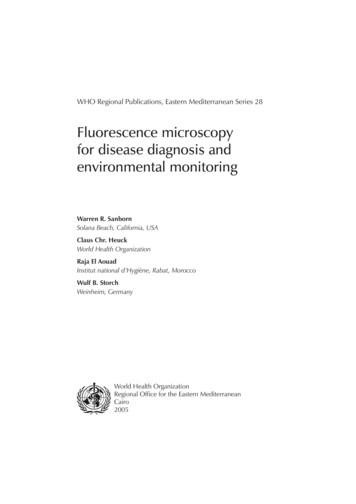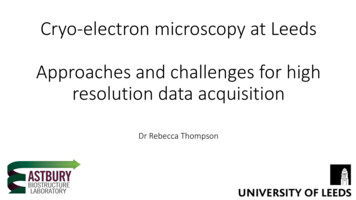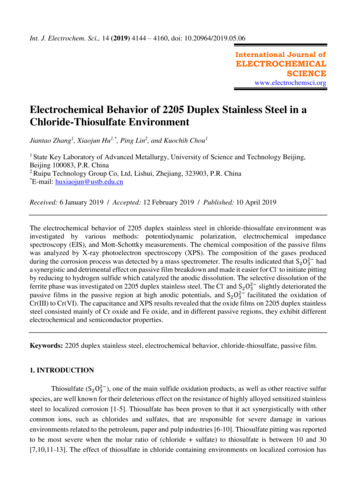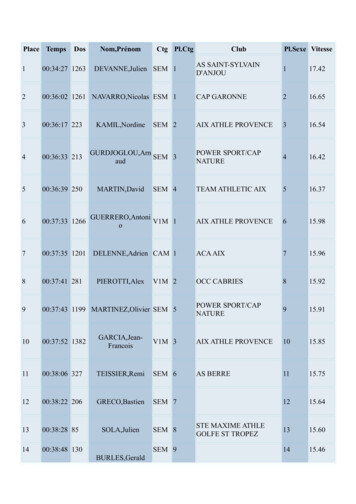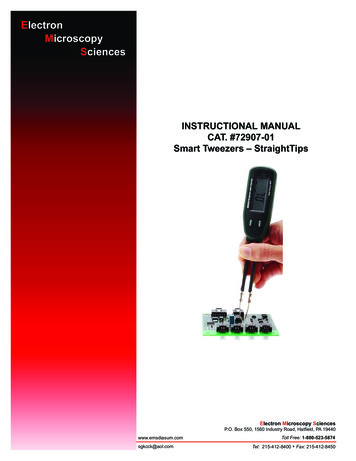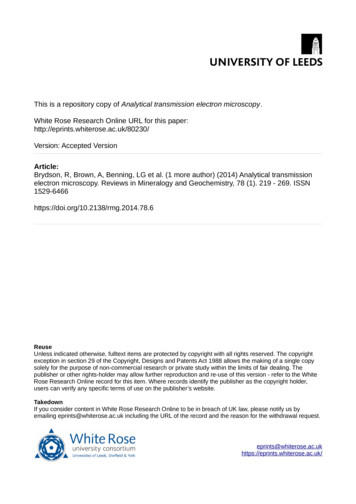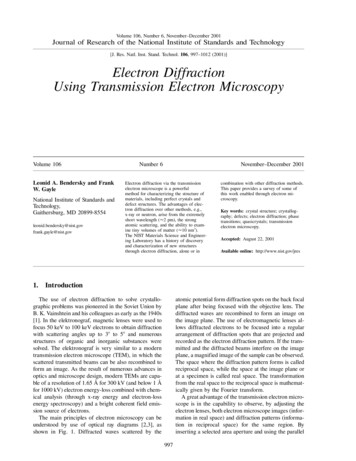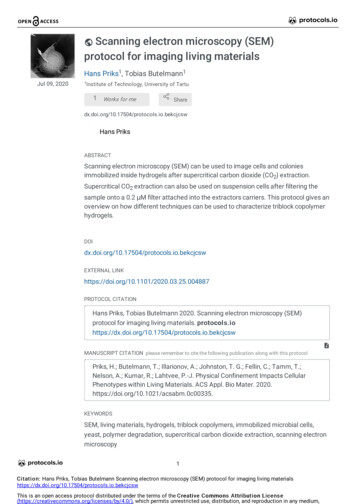
Transcription
Scanning electron microscopy (SEM)protocol for imaging living materialsHans Priks1, Tobias Butelmann1Jul 09, 20201Instituteof Technology, University of Tartu1 Works for ns PriksABSTRACTScanning electron microscopy (SEM) can be used to image cells and coloniesimmobilized inside hydrogels after supercritical carbon dioxide (CO2) extraction.Supercritical CO2 extraction can also be used on suspension cells after filtering thesample onto a 0.2 μM filter attached into the extractors carriers. This protocol gives anoverview on how different techniques can be used to characterize triblock s.io.bekcjcswEXTERNAL COL CITATIONHans Priks, Tobias Butelmann 2020. Scanning electron microscopy (SEM)protocol for imaging living materials. io.bekcjcswMANUSCRIPT CITATION please remember to cite the following publication along with this protocolPriks, H.; Butelmann, T.; Illarionov, A.; Johnston, T. G.; Fellin, C.; Tamm, T.;Nelson, A.; Kumar, R.; Lahtvee, P.-J. Physical Confinement Impacts CellularPhenotypes within Living Materials. ACS Appl. Bio Mater. DSSEM, living materials, hydrogels, triblock copolymers, immobilized microbial cells,yeast, polymer degradation, supercritical carbon dioxide extraction, scanning electronmicroscopy1Citatio n: Hans Priks, Tobias Butelmann Scanning electron microscopy (SEM) protocol for imaging living bekcjcswThis is an open access protocol distributed under the terms of the Creative Co mmo ns Attributio n 0/), which permits unrestricted use, distribution, and reproduction in any medium,
LICENSEThis is an open access protocol distributed under the terms ofthe Creative Commons Attribution License, which permits unrestricted use,distribution, and reproduction in any medium, provided the original author and sourceare creditedCREATEDApr 03, 2020LAST MODIFIEDJul 09, 2020PROTOCOL INTEGER ID35172MATERIALS TEXTReagents:formaldehydeEthanol, 99.5 - 100 %MilliQ water, sterile0.2 M phosphate buffer (20.44 g of Na2HPO4 and 6.72 g of NaH2PO4 per litre)liquid N2Supplies:falcon tubes/ependorfs/glass vialsscalpels12.5 mm aluminum SEM pin stubsconductive double sided carbon tabs/tapesharpie markerSAFETY WARNINGSFormaldehyde (FA) is toxic and should handled accordingly. Wear protective gear!N2 cooled scalpels can break during sample cutting. Wear protective eyewear!Supercritical CO2 extraction involves high pressure. Do not leave extractor unattendedwhile chamber temperature is rising.Sample fixation1Prepare fixation solution (3.7 % volume formaldehyde in30m0.1 Molarity (M) phosphate2Citatio n: Hans Priks, Tobias Butelmann Scanning electron microscopy (SEM) protocol for imaging living bekcjcswThis is an open access protocol distributed under the terms of the Creative Co mmo ns Attributio n 0/), which permits unrestricted use, distribution, and reproduction in any medium,
buffer)2Submerge sample into the fixation solution and incubate atRoom temperature for1d24:00:003Replace fixation solution and incubate atSample DehydrationRoom temperature for24:00:001d1d 0h 30m4Prepare ethanol (EtOH) dilutions in milli-Q water as indicated below.5Samples are dehydrated at30m1dRoom temperature in an ascending EtOH series (40 – 90 %,10 % steps; 96 %, 99.5 %).Submerge sample into EtOH solution, let it incubate (minimum02:00:00 per step), changethe EtOH solution.EtOH steps:1.40 % volume EtOH2.50 % volume EtOH3.60 % volume EtOH4.70 % volume EtOH5.80 % volume EtOH6.90 % volume EtOH7.96 % volume EtOH8.99.5 % volume EtOH (9.99.5 % volume (for storage)Overnight )3Citatio n: Hans Priks, Tobias Butelmann Scanning electron microscopy (SEM) protocol for imaging living bekcjcswThis is an open access protocol distributed under the terms of the Creative Co mmo ns Attributio n 0/), which permits unrestricted use, distribution, and reproduction in any medium,
Supercritical CO2 extraction67h 25mCool the critical point dryer (E3100, Quorum Technologies) to1h15 C with a thermostat(Proline RP 1845, LAUDA) using thermostat external temperature probe.5m7Connect the critical point dryer outlet to a bottle containing EtOH (half full) under fume hood (itis used to capture residues during extraction and to estimate the gas realese speed).8Open the critical point dryer and mount the samples. Close the critical point dryer according toproducers instructions.9Open CO2 inlet and fill the chamber with liquid CO2.10Slightly open the outlet and purge the chamber for10m2m10m00:05:00 (bubbling inside the externalEtOH bottle should not be too intensive).After purging close the outlet first then the inlet (to avoid pressure drop inside the chamber).11The chamber should be purged with fresh CO2 6 – 8 times in 30 – 60 min intervals (let the6hEtOH diffuse out of the structure and purge it out of the chamber, use shorter intervals at thebeginning of this process).open the CO2 inlet, then slightly open the outletpurge for00:05:00close the outlet, then close the CO2 inletrepeat 6-8 times in 30 – 60 min intervals12Increase the thermostat temperature to1h 30m37 C (inlet and outlet of the chamber should beclosed at this point).Do not leave the critical point dryer unattended while the temperature is rising as the pressurecan exceed the safety limit of the chamber.Control the internal pressure so it does not exceed 110 bar by opening the chamber outlet(should be done slowly as too fast gas release can cool the reactor and turn supercritical stateback to liquid state).4Citatio n: Hans Priks, Tobias Butelmann Scanning electron microscopy (SEM) protocol for imaging living bekcjcswThis is an open access protocol distributed under the terms of the Creative Co mmo ns Attributio n 0/), which permits unrestricted use, distribution, and reproduction in any medium,
Adjust the outlet so that the pressure gauge stays stable around 105 bar as the temperature isrisingLeave the outlet open as it is, when37 C is achieved (do not open the outlet more, as thefaster gas release can cool the reactor).Step 12 includes a Step case.SLOWFASTstep caseSLOWFig ure 1 Slow pressure release (A) vs. fast pressure release (B)13Leave the outlet open until the chamber is ready to be opened (Overnight ).12hAs the pressure drops so does the bubbling.Adjust the outlet so that there is always slight bubbling (do not over do it as it can result in poreformation figure 1B )1410mBefore opening the chamber remove outlet tube from EtOH bottle that is situated under thehood (to avoid sucking EtOH into the chamber while opening it).Remove samples from the chamber and store in a sealable container (ependorf, glass vial,falcon tube)Sample cutting and mounting155mAttache conductive double sided carbon tabs/tape on aluminum SEM pin stubs and then lablethem with a sharpie marker.5Citatio n: Hans Priks, Tobias Butelmann Scanning electron microscopy (SEM) protocol for imaging living bekcjcswThis is an open access protocol distributed under the terms of the Creative Co mmo ns Attributio n 0/), which permits unrestricted use, distribution, and reproduction in any medium,
5m16Fig ure 3 : Sample cutting - ex po sing cell-material interactio ns in hydro g els. Varying the sampleand the blade temperature together with the speed of cutting can be used to demonstrate various aspects ofLMs. A combination of sample and scalpel cooling ( 20 s) together with fast incisions results in the mostaccurate SEM images in terms of polymeric material and colony localization (A, B), but with this technique itis impossible to evaluate the colony size and shape because of the unknown location of the obtained crosssection in respect to the colony. A shorter duration of sample and scalpel cooling ( 10 s) together withslow incision highlights biologically relevant information such as cell-polymer encapsulations (Figure 5 A C) and colony size and shape (C, D) but results in cutting marks across the polymer (D). Different samplecuttings and resulting images: samples prepared with longer cooling of sample and scalpel showingrelatively smooth cuts (A, B). Samples prepared with short sample and scalpel cooling showing clearcolonies (C, D).16.1Fast incision (Figure 3: A, B) - for acquiring artifact-free crosssectionsImmerse the sample with forceps and scalpel into liquid N2 for20s00:00:20and instantly cut with fast incision (N2 cooled scalpels can break duringsample cutting. Wear protective eyewear!).16.215sSlow incision (Figure 3: C, D) - for acquiring information of colonymaterial interactions, colony size and shapeImmerse the sample with forceps and scalpel in liquid N2 forcut after00:00:10 and00:00:03 at room temperature with slow incision.6Citatio n: Hans Priks, Tobias Butelmann Scanning electron microscopy (SEM) protocol for imaging living bekcjcswThis is an open access protocol distributed under the terms of the Creative Co mmo ns Attributio n 0/), which permits unrestricted use, distribution, and reproduction in any medium,
17Using forceps, pick up the cut sample and gently press it onto the two-sided carbon tape.1mSputter Coating18Coat the sample with a1h7.5 nm gold layer using a high vacuum sputter coater (EM ACE600,Leica Microsystems).SEM imaging191d1dGold-coated samples were imaged with a tabletop scanning electron microscope (TM3000,Hitachi).The imaging was done under a high vacuum and 15 kV accelerating voltage.7Citatio n: Hans Priks, Tobias Butelmann Scanning electron microscopy (SEM) protocol for imaging living bekcjcswThis is an open access protocol distributed under the terms of the Creative Co mmo ns Attributio n 0/), which permits unrestricted use, distribution, and reproduction in any medium,
Supercritical CO2 extraction 7h 25m 6 Cool the critical point dryer (E3100, Quorum Technologies) to 15 C with a thermostat (Proline RP 1845, LAUDA) using thermostat external temperature probe. 7 Connect the critical point dryer outlet to a bottle containing EtOH (half full) under fume hood (it is used to capture residues during extraction and to estimate the gas realese speed).

